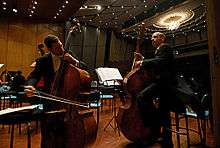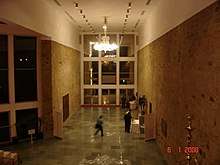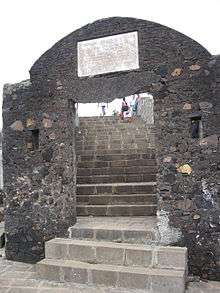National Centre for the Performing Arts (India)
| National Centre for the Performing Arts (India) Founded by JRD Tata and Dr Jamshed Bhabha | |
|---|---|
|
| |
 Location within Mumbai | |
| General information | |
| Type | Arts, complex |
| Architectural style | ( Then International Style) |
| Location | Mumbai, India |
| Address | National Centre for the Performing Arts, NCPA Marg & Dorabji Tata Road, Nariman Point, Mumbai -40001, India. |
| Coordinates | 18°55′30″N 72°49′14″E / 18.9251°N 72.8206°ECoordinates: 18°55′30″N 72°49′14″E / 18.9251°N 72.8206°E |
| Construction started | 1981 |
| Completed | 1985 |
| Opened | 1986 |
| Height | 46.28m |
| Technical details | |
| Structural system | Concrete Frame |
| Design and construction | |
| Architect | Philip Johnson-concept part; Principal architect Rustom Patell of Patell Batliwala & Associates |
| Main contractor | Larsen & Toubro Limited |
The National Centre for the Performing Arts (NCPA) is a multi-venue, multi-purpose cultural centre in Mumbai, India, which aims to promote and preserve India's heritage of music, dance, theatre, film, literature and photography. It also presents new and innovative work in the performing arts field. The Centre was founded in 1969 by JRD Tata and Dr. Jamshed Bhabha,[1] (brother of nuclear physicist Homi Jehangir Bhabha).
The NCPA is also the home of the Symphony Orchestra of India, which was established by NCPA in 2006.[2] In 2010 the orchestra performed Beethoven's 9th Symphony in Moscow at the 5th World Symphony Orchestra Festival - the first time an orchestra from India had performed there.
Principal aims and objectives

- To establish a national centre for the preservation and promotion of classical, traditional and contemporary performing and visual arts.
- To establish, equip and maintain schools, auditoria, libraries, archives, museums, studios, workshops and other facilities necessary to fulfil the above objectives.
- To disseminate knowledge, promote appreciation, provide training and sponsor or undertake scientific research in these fields with the objective of further development by encouragement of innovation within India and by interaction with the arts of other countries.
Theatres

The NCPA complex occupies an area of about 32,000 square metres (340,000 sq ft) at Nariman Point, on land reclaimed from the sea.
It has 5 theatres in its premise, each catering to a unique genre of performing arts
Jamshed Bhabha Theatre, From large format orchestras to full-scale operas, the most technically complex performances can be staged at this Proscenium theatre with a seating capacity of 1,109. Named after the founder, and operational since 1999, its technical facilities allow for international productions of opera, ballet and major musicals.
This well-equipped, elegant theatre also boasts of a historic marble staircase and a dazzling double-level foyer. The entire staircase was transplanted from another location; more as an art object or architectural folly. It is, undoubtedly, the cornerstone for theatrical extravaganzas staged in South Asia.
Tata Theatre, This distinctive space that can seat 1,010 is the best of both worlds. It effortlessly combines the intimate ambience of a small-scale venue with the splendour of a full scale arena. A revolving stage, brilliant acoustics and a foyer with a scenic view of the sea are just some of the things that make the Tata Theatre the venue of choice for both, performers and audiences.Created by the renowned American Modernist architect Philip Johnson ( concept part) Rustom Patell-Patell Batliwala & Associates principal designer and the legendary acoustician Cyril Harris, this theatre opened in 1982. Today, it is Mumbai's preferred venue for Indian classical concerts, Western chamber music and theatre.
Experimental Theatre, As flexible as its name, this theatre opened in 1986 and has 300 movable seats which allow it to be configured to suit a range of events. Its unique 'black box' auditorium is the perfect platform for innovative theatre productions as well as small-scale dance and music performances. It also doubles up as a teaching and workshop space.
Other facilities
- Piramal Art Gallery
- Reading and listening libraries
- Studio for archival documentation of dance, drama and music
- Teaching and research block
- Computerised music research laboratory
- Audio-visual archival vault with over 4,000 hours of recording and theatre research material, and a computerised databank for easy retrieval
Performances
Throughout the years NCPA hosted many performances including classical, traditional and contemporary performing arts in dance, theatre, and music. Notable Indian performers who performed at NCPA include Vilayat Khan, M. S. Subbulakshmi, Birju Maharaj, Kelucharan Mohapatra, Savitha Sastry, Mani Madhava Chakyar, Shakuntala, Smita Patil, Parveen Sultana and Shabana Azmi.[3]
NCPA has also attracted many international performers including Yehudi Menuhin, Israel Philharmonic Orchestra, Navoi Bolshoi Ballet of Uzbekistan,[4] Marcel Marceau, Barber of Seville opera, production of Jane Eyre,[3] and other British Council commissioned theatre productions.[5] In 2006, New Jersey Ballet staged India's first full-length classical ballet with its Nutcracker production.[6][7] In 2016, NCPA in association with Shapoorji Pallonji Group, co-produced Mughal-e-Azam, a Broadway-style musical based on the 1960 Bollywood film Mughal-e-Azam, which was directed by K. Asif and produced by Shapoorji Pallonji. [8] [9]
See also
References
- ↑ "NCPA". NCPA Mumbai. Retrieved 2018-05-19.
- ↑ "Symphony Orchestra of India". NCPA Mumbai. Retrieved 2013-09-25.
- 1 2 Performances at the NCPA – accessed 29 March 2009
- ↑ The Bolshoi Symphony Orchestra - Navoi Bolshoi Ballet (Uzbekistan) – accessed 29 March 2009
- ↑ A Midsummer Night's Dream – accessed 29 March 2009
- ↑ New Jersey Ballet presents Tchaikovsky program. New Jersey Herald. - accessed on 28 March 2009
- ↑ Birajdar, Laxmi. Western classical music fans in for a treat. Pune Newsline. 12 September 2006 - accessed on 29 March 2009
- ↑ "Mughal-e-Azam (musical)". Wikipedia. 2018-05-15.
- ↑ "'Mughal-e-Azam': An Audacious Screen-to-Stage Adaptation Of The K. Asif Classic". HuffPost India. 2017-09-12. Retrieved 2018-05-22.
